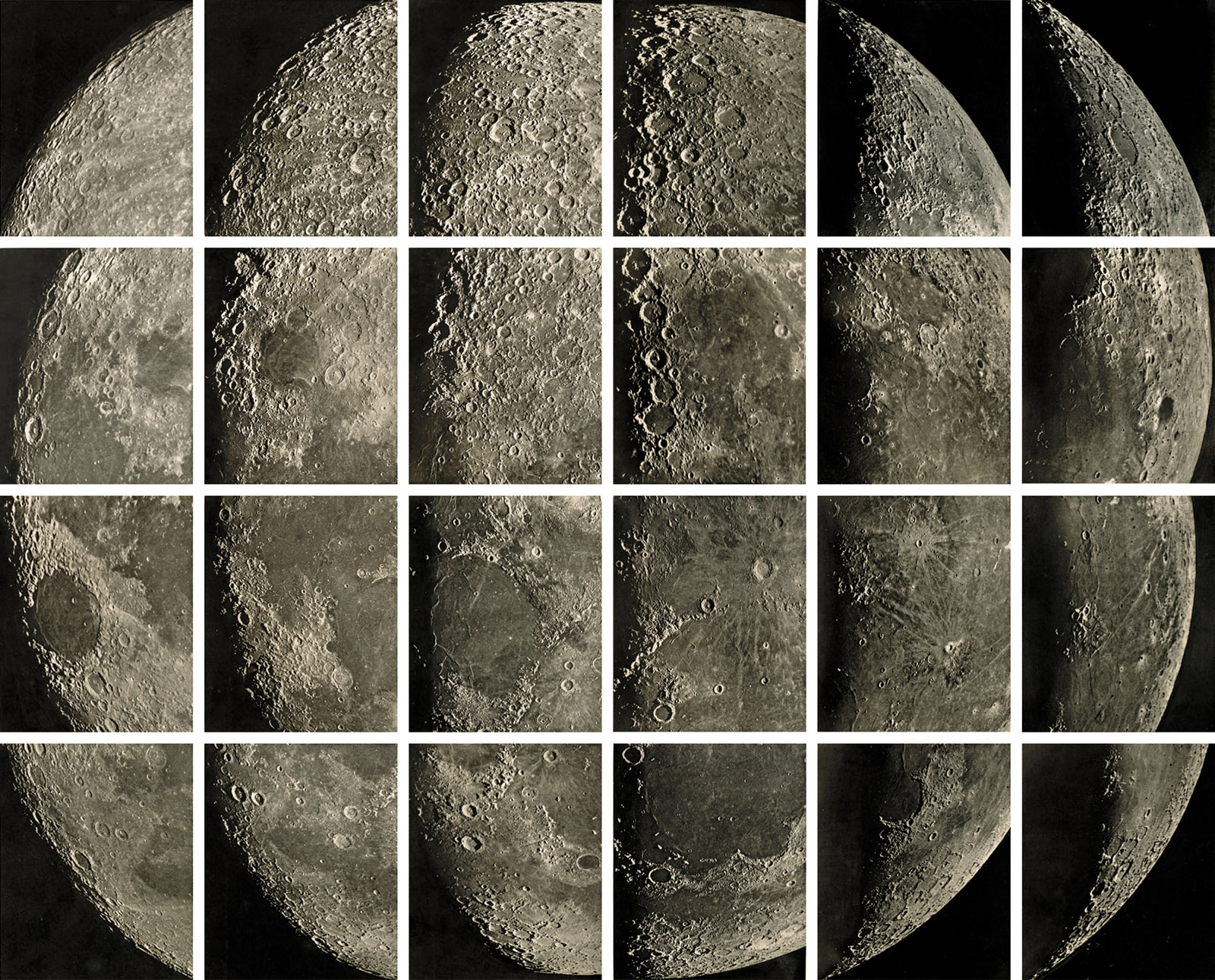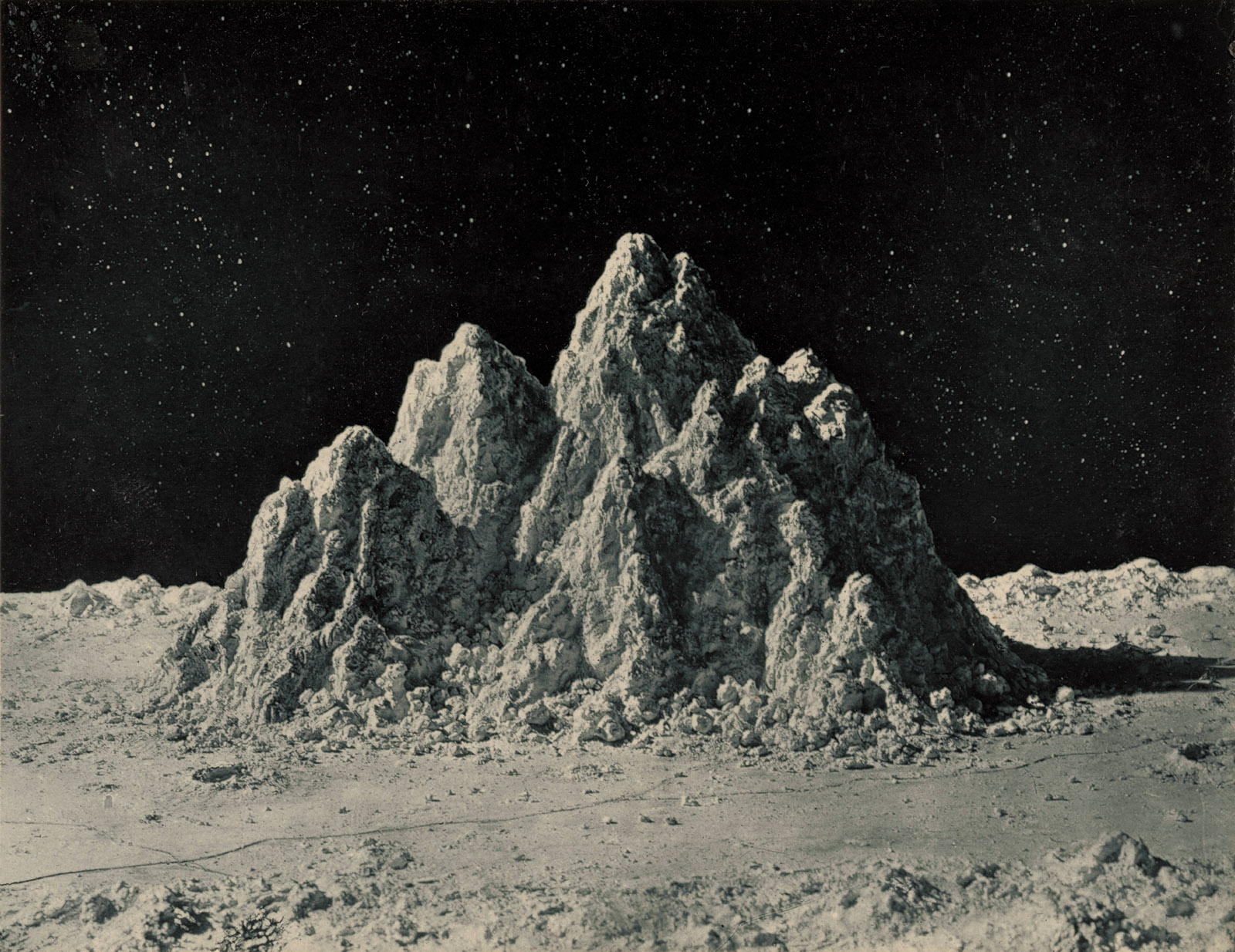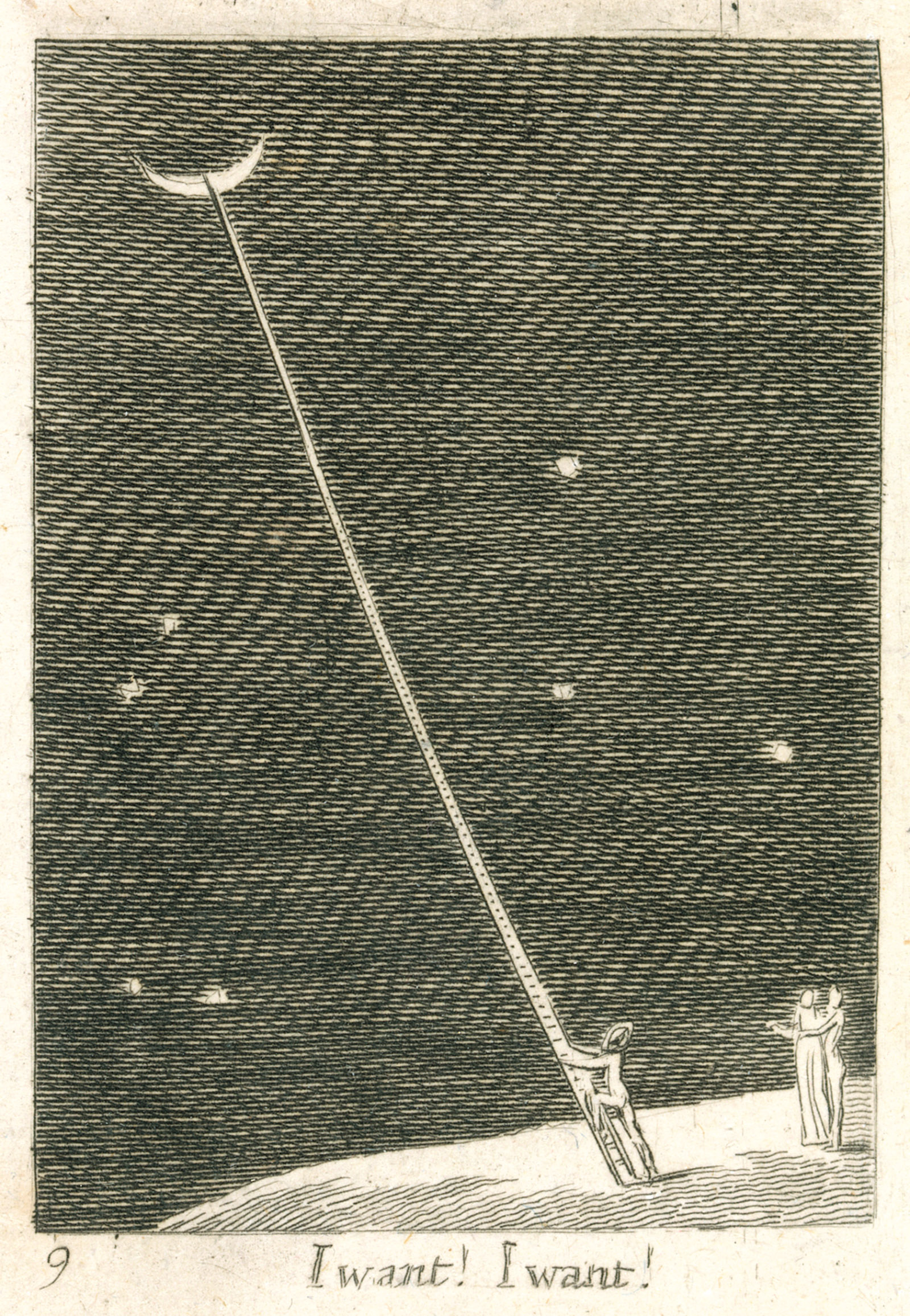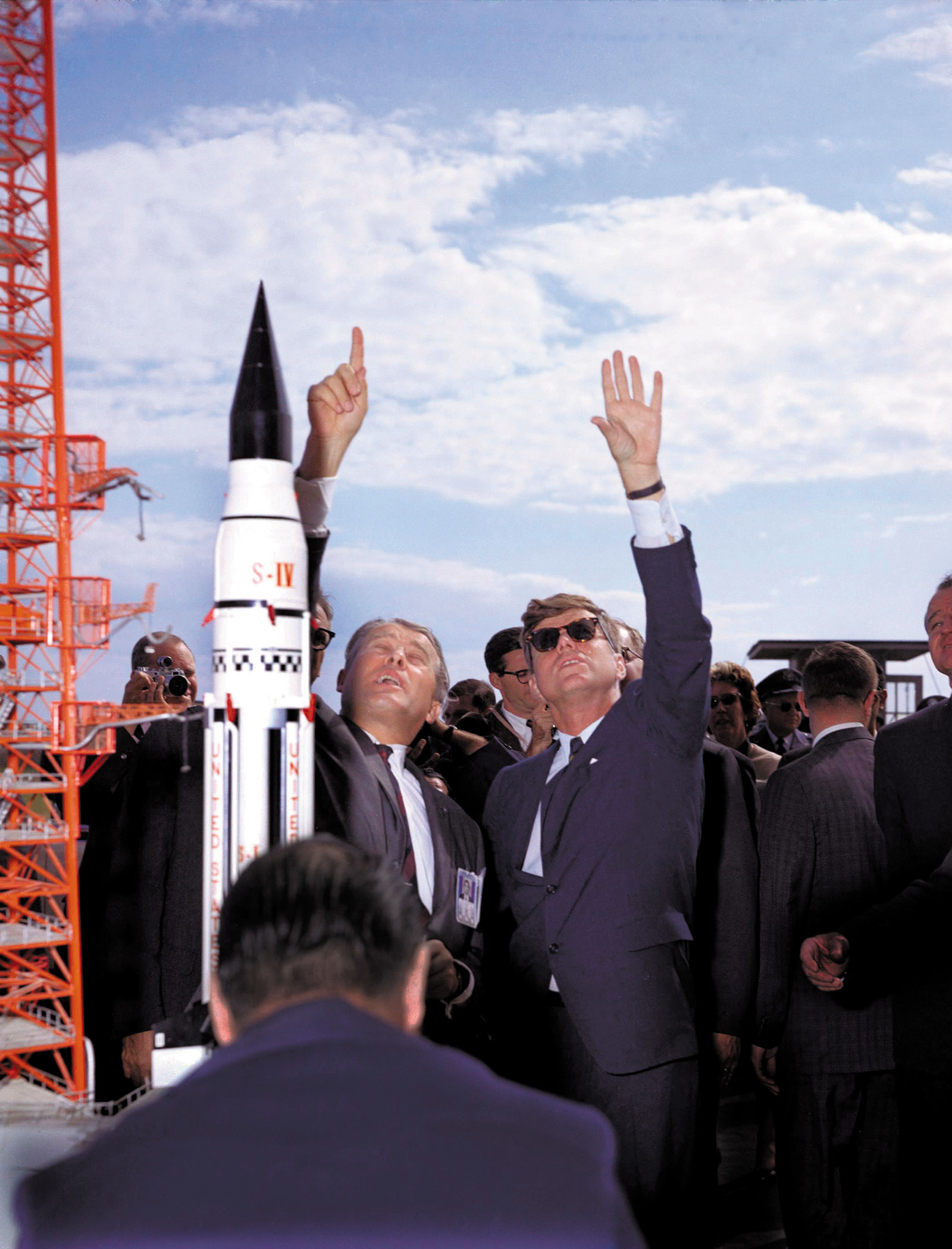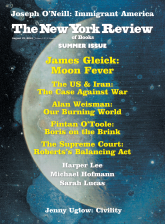High and preposterous and separate—
Lozenge of love! Medallion of art!
—Philip Larkin
First it was a heavenly body—a beacon, or a world, a place where no one could possibly go. Then, from 1969 to 1972, twelve people landed there in spaceships. On behalf of all humanity, they said. Is it time to go back?
Moon fever is rising. The fiftieth anniversary of the first lunar landing has stirred dormant memories and produced a bounty of books, films, and exhibitions. Meanwhile, technocrat billionaires have helped catalyze a new moon race. Elon Musk is marketing moon trips to the superrich, and Jeff Bezos says we should colonize the moon to save the earth. China landed a robot called Jade Rabbit 2 on the far side in January, and India is trying to get a water-seeking rover, Chandrayaan-2, to the lunar south pole.
“The Return to the Moon is coming,” says the British science writer Oliver Morton in The Moon: A History for the Future, “and it will be undertaken by men and women from many more places, and with more agendas, than were in the American vanguard of 50 years ago.” Early in his administration, Donald Trump promised a new moon landing in his Space Policy Directive 1—a two-sentence amendment to Barack Obama’s comprehensive fourteen-page National Space Policy—declaring that “the United States will lead the return of humans to the Moon for long-term exploration and utilization.” (On the other hand, he recently undermined his own policy by tweet, on June 7: “For all of the money we are spending, NASA should NOT be talking about going to the Moon—We did that 50 years ago.”)
The first moon landing was at once a historical inevitability and an improbable fluke. Inevitable because we had already done it so many times in our storytelling and our dreams. Astonishing, even in hindsight, because it required such an unlikely combination of factors and circumstances. “The moon, by her comparative proximity, and the constantly varying appearances produced by her several phases, has always occupied a considerable share of the attention of the inhabitants of the earth,” remarks Jules Verne in his fantastic tale From the Earth to the Moon (1865). The French fabulist imagined that the pioneers of space would be none other than Les Yankees: “They had no other ambition than to take possession of this new continent of the sky, and to plant upon the summit of its highest elevation the star-spangled banner of the United States of America.”
To get there, Verne proposed a projectile fired from a giant gun. He had probably read Edgar Allan Poe’s story “The Unparalleled Adventure of One Hans Pfaall” (1835), in which a Dutchman journeys to the moon by lighter-than-air balloon and meets the inhabitants, “ugly little people, who none of them uttered a single syllable, or gave themselves the least trouble to render me assistance, but stood, like a parcel of idiots, grinning in a ludicrous manner.” Like Poe, Verne embellished his story with a great deal of plausible science involving computations of the moon’s elliptical orbit, the distances to be traveled at apogee or perigee, the diminishing force of gravitation, and the power of exploding gunpowder.
Hans Christian Andersen, Daniel Defoe, Cyrano de Bergerac, and many others had already spun stories of voyaging to the moon and meeting its natives. Verne seems to have been the first to describe the moon as it really is: desolate and uninhabited. Morton shows that he relied on the obsessive work of a Scottish engineer and artist, James Nasmyth, who observed the moon through his home-built twenty-inch telescope and made a series of drawings and clay models of the cratered lunar landscape. (See illustration above.) Verne’s moon is Nasmyth’s, Morton writes: “One of mountainous annular volcanoes, lofty impassable ramparts and little else. In particular: no air, no streams, no woods, no life.” It is, as Verne said, “beyond the pale of humanity.”
Some of Nasmyth’s photographs can be seen in a superb exhibition, “Apollo’s Muse: The Moon in the Age of Photography,” now at the Metropolitan Museum. They are peculiar and fantastic, using plaster and staged lighting to create images of mountains and craters that could not yet be properly seen—a new kind of imaginative fiction posing as science. Indeed, scientists were eager to believe: “No more truthful or striking representations of natural objects than those here presented have ever been laid before his readers by any student of science,” the journal Nature declared in March 1874. Nasmyth was building on a project that began in 1609, when Galileo Galilei spent an obsessive fortnight in a Venetian church tower drawing the spotted and shadowed disk he saw through his new telescope. He inspired fantasies. Francis Godwin, an English bishop, published The Man in the Moone in 1838, with a woodcut showing a flying machine powered by geese. William Blake drew a poignant ladder to the crescent moon captioned, “I want! I want!” (See illustration below.) Across four centuries of lunar imagery, these artistic visions and deliberate hoaxes evolved side by side with astronomers’ efforts to perfect a photographic atlas of the entire moon—or rather, the tide-locked hemisphere we can see from here. The far side had to remain invisible and uncharted.
Advertisement
Generations of science-fiction writers had sent space-faring heroes to the moon and beyond, and generations of scientists had grown up reading their stories. Robert H. Goddard, who grew up in Worcester, Massachusetts, in the last decades of the nineteenth century and as a teenager read H.G. Wells’s “scientific romance” The War of the Worlds, invented many of the essential technologies for rocketry: gyroscopes for stabilization, steerable thrust, and, most notably, liquid-fuel rockets. On his aunt’s farm in the winter of 1926, he launched his first successful test: a six-pound aluminum rocket that climbed forty feet before crashing back onto the snow. After reporting that he “Believes Rocket Can Reach Moon,” The New York Times mocked Goddard for thinking a rocket could produce thrust in a vacuum, with no atmosphere to push against. The paper published a formal correction forty-nine years later, on July 17, 1969, while the Apollo 11 astronauts were en route.
For Russians, rocket history begins with the visionary Konstantin Tsiolkovsky. Another devotee of Jules Verne, Tsiolkovsky published the evangelizing work Explorations of the Space of the Universe by Jet-Propelled Instruments (1903), which imagined a multistage spacecraft that would jettison sections as their fuel burned off. “Earth is the cradle of humanity. But mankind cannot stay in the cradle forever,” he wrote. The first extended progress in rocket science, however, came from Germans, who founded an amateur rocket association called the Society for Space Travel in 1927. The society helped inspire the director Fritz Lang and his wife and collaborator, Thea von Harbou, to create one of the first science-fiction films, Woman in the Moon. (Among other inventions, the film features the first “countdown.”)
The society’s bible was a ninety-two-page book, The Rocket into Planetary Space, by the physicist Hermann Oberth. Short of space travel, what would their rockets be good for? Willy Ley, who later became a science writer in the US, recalled asking Oberth if there would ever be a need for rockets carrying loads of mail: “Oberth looked at me with the smile which old-fashioned pedagogues reserve for people whom they call ‘my dear young friend’ and said after a while: ‘There will be need for rockets which carry a thousand pounds of dynamite.’”
By 1944, the German V-2 carried a ton of explosive atop a fourteen-ton, forty-six-foot rocket with a range of more than two hundred miles. Many of the society’s amateur enthusiasts had made a smooth transition to the Wehrmacht—particularly the young, handsome Wernher von Braun, who joined the Nazi Party, became an SS officer, and soon led a research team on rocket artillery. Five years before the US began its project to design an atomic bomb, the Third Reich established an enormous secret facility to develop long-range rockets at Peenemünde, on the Baltic Sea. Von Braun still had ideas about sending a rocket to the moon, but he was warned never to mention that to Hitler. The Führer was counting on a miracle weapon—a Wunderwaffe.
What he got was poorly guided and barely controllable, too late and too ineffectual to save his failing war. Three thousand V-2s were launched beginning in the last months of 1944, killing civilians in England and Belgium almost randomly. There was no defense and no warning. In all, about nine thousand people died in V-2 attacks. Far more were killed producing the rockets: at least 12,000 slave laborers, many from concentration camps, tortured and beaten, deprived of food and care.
It was from the ruins of the V-2 program that the space race was born. With some justice, Douglas Brinkley in American Moonshot calls the American capture in May 1945 of von Braun’s blueprints and drawings, along with tons of V-2 parts, “one of the great technology grabs in history.” Von Braun himself had been scheming for months to surrender to the US, and army intelligence welcomed him like a grandee. The potentially awkward question of war crimes disappeared under the carpet. The Red Army, meanwhile, captured Peenemünde and rounded up as many engineers and rocket scientists as it could find—far fewer than von Braun delivered to the Americans, but enough to jump-start Stalin’s new program for development of ballistic missiles and rocket engines.
Advertisement
Von Braun’s new country lionized him. “Swooning reporters treated him as half rocket scientist, half charming and cultured poet/raconteur, imbued with a deep affinity for all things American,” Brinkley writes. More than any other scientist, he became the face of the space program, adorning magazine covers and eventually receiving the 1975 National Medal of Science. But the time when his story could be whitewashed is past. Brinkley’s assessment is appropriate:
Von Braun’s amoral hunger to construct rockets governed his embrace of an evil regime. Both during World War II and after, he accepted accolades as an engineering visionary who foresaw the potential of human spaceflight, never admitting that he was essentially a fast-track Nazi arms merchant who developed brutal weapons of mass destruction.
While the rocket scientists labored under the patronage of their militaries to create larger and more powerful engines, science-fiction writers leapt ahead in visualizing space exploration. In Rocket Ship Galileo (1947), Robert Heinlein sent teenage heroes to the moon, where they discover a hidden Nazi base; in The Man Who Sold the Moon (1950), his protagonist is a business tycoon—“the last of the robber barons.” Arthur C. Clarke—before he wrote the story that became 2001: A Space Odyssey—published a scientific paper proposing communication satellites to overcome the limited range of radio and television transmission and enable broadcasts across the entire globe. A fast-enough rocket, he explained, would “become an artificial satellite, circling the world for ever with no expenditure of power—a second moon, in fact.”
Nonetheless, most of the world was taken by surprise on October 5, 1957, when the Soviet Union announced it had sent up an “artificial moon”: a two-foot sphere weighing 184 pounds, with two small radio transmitters sending beeps into the ether. By the time Americans saw the headlines in their morning papers, Sputnik had already passed over the US four times. Panic ensued. “Americans quite nearly lost their minds,” writes Brandon R. Brown in The Apollo Chronicles, an excellent history of the space program through the eyes of its engineers and scientists. “What did it mean that our enemies, at unprecedented speeds and heights, could methodically paint these bands—these orbits—again and again over our skies? Could the Sputnik see us?” Amateur skygazers searched the heavens with their binoculars and telescopes. Ham radio hobbyists tuned in to the hypnotic beep, transmitted with a single faint watt of power. Sputnik was on everyone’s lips. If it wasn’t for Sputnik, we wouldn’t have had “beatniks,” “peaceniks,” or “no-goodniks.” And we wouldn’t have had an American moon landing in 1969.
“The only appropriate characterization that begins to capture the mood on October 5 demands the use of the word hysteria,” writes Roger D. Launius, a longtime NASA historian, in Reaching for the Moon. “A collective mental turmoil and soul-searching followed, as American society thrashed around.” The coverage blanketing The New York Times that Sunday included, among other headlines, “World Reshaped Within a Lifetime,” “Sphere Crossing US 7 Times a Day,” “Amateurs Hear ‘Moon’s’ Signals,” “Sphere Believed Invisible in US,” “A Propaganda Triumph,” and “Senators Attack Missile Fund Cut.” The Eisenhower White House said mildly that the launch was, “of course, of great scientific interest.” Democratic politicians saw an opportunity. The junior senator from Massachusetts, John F. Kennedy, was already positioning himself as a vigorous cold warrior, assailing the Eisenhower administration for what he labeled “the missile gap.” Lyndon Johnson, another presidential hopeful, said, “Soon, [the Russians] will be dropping bombs on us from space like kids dropping rocks onto cars from freeway overpasses.”
Within a year, Eisenhower had created the National Aeronautics and Space Administration—reluctantly, because he saw it fostering the centralization of power and technology that he soon called “the military-industrial complex.” Nonetheless, the new agency gathered resources, retooled quickly, and selected seven military pilots to be America’s first “astronauts” in Project Mercury. They would ride into orbit in tiny capsules atop an Air Force ICBM, the Atlas.
In fact, there was no missile gap. When Kennedy took office in 1961, the United States had many more ICBMs than the Soviet Union, and they were more powerful and more accurate. Kennedy’s inspiring inaugural address said nothing about space or the moon. Meanwhile, Moscow’s secretive space program was—we can see in hindsight—scrappy but underfunded and prone to mistakes. It never announced its disasters. It killed a dog, Laika, by sending her spaceward on Sputnik 2, and celebrated the poor animal with stamps and statues.
Nonetheless, for 108 minutes in April 1961, Yuri Gagarin became the first human in space. (The Soviets pretended that Gagarin had completed a full earth orbit, but they falsified the takeoff and landing locations. They also concealed the embarrassing fact that they had no way to bring a spaceship safely to the ground: we know now that Gagarin survived by ejecting with a parachute four miles above the surface.) Gagarin’s triumph created a public relations problem for the new president, and another arrived five days later, when the CIA sent an ersatz brigade of Cuban exiles on a disastrous invasion at the Bay of Pigs.
Three days after that, Kennedy sent his vice-president a memo: “Do we have a chance of beating the Soviets by putting a laboratory in space, or by a trip around the moon, or by a rocket to land on the moon, or by a rocket to go to the moon and back with a man.” He added desperately, “Is there any other space program which promises dramatic results in which we could win?” Johnson quickly gathered experts from the space agency, the military, and the private sector. He told them to think big.
So Neil Armstrong, Buzz Aldrin, and Mike Collins went to the moon. The enthralling new documentary by Todd Douglas Miller, Apollo 11, ends with their homecoming: tearing through the earth’s atmosphere in a fireball, splashing into the Pacific, hauled up by helicopter, and carried to the USS Hornet, where a brass band played and Richard Nixon and Henry Kissinger can be glimpsed waving on the flag bridge—and from behind a montage of triumphal imagery comes the unmistakable voice of John F. Kennedy in oratorical flight:
I realize that this is in some measure an act of faith and vision, for we do not now know what benefits await us. But if I were to say, my fellow citizens, that we shall send to the moon, 240,000 miles away from the control station in Houston, a giant rocket more than 300 feet tall…fitted together with a precision better than the finest watch, carrying all the equipment needed for propulsion, guidance, control, communications, food, and survival, on an untried mission, to an unknown celestial body, and then return it safely to earth, reentering the atmosphere at speeds of over 25,000 miles per hour, causing heat about half that of the temperature of the sun—almost as hot as it is here today—and do all this, and do all this and do it right, and do it first before this decade is out, then we must be bold.
We aren’t told—the documentary has no narrator and little explanatory text—but Kennedy was addressing a cheering crowd of 40,000 in a stadium at Rice University in Houston in September 1962. Brinkley ranks his speech “among the most inspiring ever delivered by an American president.” Ted Sorensen wrote most of it, but “the spirit of raw aspiration was pure JFK.”
It’s natural for Brinkley, who has made a career as a historian of presidents, to focus his history of the space race on Kennedy, for whom, as he notes,
the moonshot was many things: another weapon of the Cold War, the sine qua non of America’s status as a superpower, a high-stakes strategy for technological rebirth, and an epic quest to renew the American frontier spirit, all wrapped up as his legacy to the nation.
All that is true, as is this irony: if Kennedy had not been assassinated, he might not have been able to maintain the enormous diversion of resources to an adventure that was not nearly as popular at the time as it seems in hindsight. Johnson used his martyrdom as a cudgel to keep Congress in line. By 1966, NASA consumed 4.4 percent of the federal budget, almost ten times its current share, and employed scientists, technologists, and 400,000 contractors and subcontractors working in 50,000 different companies.
Miller’s film opens with a sight few have seen up close: the 2,700-metric-ton crawler-transporter creeping forward on eight giant treads, bearing on its quarter-acre steel platform the Saturn V rocket, taller than the Statue of Liberty. Even more unusual and momentous sights will follow. This film is a powerful generator of awe. It replaces the grainy black-and-white images of our memories with astonishingly vivid 65-mm wide-screen footage preserved for decades in the vaults of NASA and the National Archives. The young, crew-cut astronauts, somber or jovial, suiting up. Firing Room 1, with men in white shirts and dark ties sitting at consoles with black-and-white TVs or sheaves of paper or banks of lights and switches. Tens of thousands of spectators across from the Cape Canaveral launch site, crowding motel balconies, lining the waterfront at a Penney’s parking lot, or filling the bleachers at Banana Creek. The giant rocket stands shining in its xenon spotlights. Miller doesn’t need a conventional narrator because the event had one practically built in: Walter Cronkite, the CBS anchor, who had covered military aviation as a young reporter and made space exploration his special passion. His moon mission was full of superlatives:
Man begins the greatest adventure in his history. If all goes well, Apollo 11 astronauts Armstrong, Aldrin, and Collins are to lift off from pad 39A out there on the voyage man always has dreamed about…. And boring through the vastness, the blackness, and the cold of space, they’ll carry the pledge made eight years ago by President Kennedy to put a man on the moon and bring him back safely in this decade.
We hear the familiar countdown; see the explosive ignition of five engines. Can any of our authors describe this? “No words can convey the slightest idea of the terrific sound! An immense spout of fire shot up…. With great difficulty some few spectators obtained a momentary glimpse of the projective victoriously cleaving the air in the midst of the fiery vapors!” No, wait—that was Jules Verne. Morton’s book does better:
The shell of ice that had clung to the supercool metal fell in shattered sheets into the inferno below.
The fires on which it rose were not the fire that leaps or licks or plays, the fire of brasier or boiler. They were the focused fire of the metalworker’s torch, given life at a scale to cut worlds apart or weld them together…. The flames slammed into the fire pits below at six times the speed of sound.
During the first minutes of liftoff, he notes, the rocket produced as much energy as all the electric power plants of Britain.
Peering into 1969 with such immediacy, the 2019 viewer can’t help but notice how very white and very male the American space program was. Lately, the contributions of women and people of color have begun to be brought out of the shadows, in books such as Margot Lee Shetterly’s Hidden Figures (2016), and Miller’s Apollo 11 lets you glimpse a lone woman amid the hundreds of men in Firing Room 1. (A journalist for Vanity Fair tracked her down: she is JoAnn Morgan, at the time a twenty-eight-year-old instrumentation controller.)
You may also be struck by the primitive technology engineers had to work with. When telephones rang, they beat a little metal bell with a little metal hammer. In the preface to a new edition of his memoir Carrying the Fire, Michael Collins observes that the number of earthlings has swelled in fifty years from three billion to eight billion. We eight billion have seen technological development that makes 1960s rocketry look quaint. Young viewers of Apollo 11 might wonder at the reporters pecking at manual typewriters or lining up at pay phones, and they might not recognize the plastic calculating devices called slide rules. NASA had to plan orbital spaceflight in the absence of any global communications network: no real-time messaging by Internet, television, or radio. Data tapes from radar tracking stations were dispatched by courier.
“You would write out what you wanted to say on a piece of paper, you would hand it to a teletype operator, and he’d run over to the teletype machine,” one engineer told Brandon Brown. They did not have the benefit of the coming revolution in (pardon the expression) space-age materials: carbon fibers, reinforced polymers, and advanced alloys and ceramics. As for computers, the one designed for the Apollo spacecraft—“for 1966, absolutely at the bleeding edge of technology,” as Brown says—had a paltry two kilobytes of memory, which required a new technology more reliable than fragile reels of magnetic tape: seamstresses wove “ropes” of wires through tiny magnetic donuts, each storing a single bit of information. The computer itself was the size of a shoebox.
The later progress in integrated circuits and materials science surely benefited from the space program, though how much is a matter of debate. When the euphoria began to fade, technological spinoffs became a consolatory justification for the enormous expenditures. It was a cliché of the Seventies that without NASA we wouldn’t have Teflon or Tang; actually, though, both the nonstick coating and the artificial drink powder predated space flight.
The Apollo program came to be seen as a dead end. Nixon, not long after placing his famous phone call (“Hello, Neil and Buzz, I’m talking to you by telephone from the Oval Room at the White House, and this certainly has to be the most historic telephone call ever made”), shut it down with little opposition, canceling the last three planned missions and draining NASA’s budget. Kennedy’s gamble—desperate or visionary or both—had accomplished a high-water mark for American exceptionalism, and now it was over. At the end of 1972, the US had 100,000 newly unemployed aeronautics and aerospace engineers. One of them was von Braun, who had compared the lunar landing to “that moment in evolution when aquatic life came crawling up on the land.”
What was it all good for, then? Is it enough to say that we explore, we reach outward, we seek new heights? The documentary’s mode is heroic, perhaps inevitably. “The dawn of this day heralded the dawning of a new age,” Cronkite says. “It’s a time of exhilaration, reflection, hope, fulfillment as a centuries-old dream starts toward reality.” I felt that at the time, as a teenager, and I feel it still.
The books are naturally more reflective, and the authors differ in their purposes and their assessments. Morton is the most eloquent and expansive. He sees the moon through lenses of art as well as science. If it is lifeless and desolate, it is also haunted. “There was a time when the Moon, standing for all things that rockets might reach, functioned as an image of the future,” he writes. “Now it seems, at best, a future among others—and a slightly retro one.”
“Was the voyage of Apollo 11 the noblest expression of a technological age, or the best evidence of its utter insanity?” Norman Mailer asked in Of a Fire on the Moon (1971). “It was the question,” he added, “which would dog Aquarius [i.e., Mailer himself] into the tenderest roots of his brain,” and it dogs us too. Scientifically, we learned a great deal about the moon from the Apollo project: how it was formed, what it’s made of, and where (exactly) it is. We brought back eight hundred pounds of rock and left behind seismometers and magnetometers and arrays of special mirrors to reflect laser pulses. And bootprints.
But the Apollo missions did not just show us the moon. More important, they showed us the earth. The few men who went to the moon were the first to get far enough away to see the planet whole. We have absorbed their famous pictures—beginning with the one called Earthrise, made by William Anders during Apollo 8. The Blue Marble might be your screensaver; it has served as an emblem for environmental activism, and it is so familiar that we can scarcely recover a sense of what was in people’s heads before. They knew the earth was round. They had made maps. But it wasn’t the same as seeing. While Armstrong and Aldrin climbed down the ladder onto the moon’s surface, Collins had time in lunar orbit to look back toward home: “The earth appears ‘fragile,’ above all else,” he writes:
From space there is no hint of ruggedness to it; smooth as a billiard ball, it seems delicately poised on its circular journey around the sun, and above all it seems fragile…. The difference between a blue-and-white planet and a black-and-brown one is delicate indeed.
“If we can put a man on the moon, why can’t we…?” became a cliché even before Apollo succeeded. Why can’t we end poverty? Why can’t we cure the common cold? It has been termed the argumentum ad lunam. Usually it’s a false choice, or just a joke. Now, though, the missing predicate is the urgent one: why can’t we stop destroying the climate of our own planet? Perversely, some of the reviving interest in space comes from fear of our impending self-made apocalypse. There is a notion that humanity might survive as a species by sending a lucky few outward toward the stars—a final escape from doom while the home planet dies. This is a particularly mad sort of delusion.
Since the last Apollo mission in 1972, no human has traveled more than a few hundred miles into space. Space exploration has been robotized and virtualized—and it has discovered wonders. Probes have sent back astounding sights: sunrise on Mars, Jupiter’s storms, Saturn’s rings and moons. Black holes and exoplanets were vaguely science-fictional; now we can see them. Will we go to Mars? We’re already there. The robot named Curiosity has been trundling across sand dunes and mountain slopes and ancient stream beds for almost seven years, drilling into rocks and taking selfies. A NASA spacecraft called OSIRIS–REx is currently in tight orbit around an asteroid, preparing to scoop up a sample. The most venerable of all space explorers, Voyager 1 and 2, have passed Jupiter, Saturn, Uranus, and Neptune and flown onward into interstellar space.
By contrast, the dawning of space tourism seems ignoble. NASA announced in June that it would rent out the International Space Station to private parties for $35,000 a night per person, a pittance considering that any customer will have paid someone else tens of millions of dollars for the trip by rocket. A Japanese billionaire, Yusaku Maezawa, has booked a putative voyage around the moon with Elon Musk’s SpaceX company. “I will be heading to the moon,” he claims, “just a little earlier than everyone else.” He’s calling it an art project. You might call it thrill-seeking for plutocrats. Looked at coolly, the moon doesn’t seem promising as a tourist destination. If it were on earth, no one would want to go there.
I say leave it alone for a while. When we looked close up, we found barren sand, inanimate rock of indeterminate color, and no urgent reason to stay. The moon abides. It rules the firmament. Waning crescent, waxing gibbous, it raises the oceans and tugs at our thoughts. “It still holds the key to madness,” E.B. White wrote fifty years ago, “still controls the tides that lap on shores everywhere, still guards the lovers who kiss in every land under no banner but the sky.”
This Issue
August 15, 2019
The Ham of Fate
Burning Down the House
Real Americans


